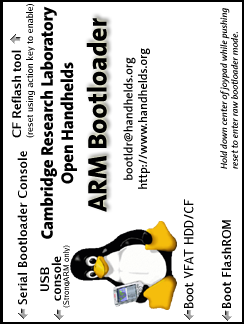Hold down the joypad and push the reset button on the iPAQ. You will need to remove it from the cradle to access the reset button.
- For non-H5xxx:
When the bootloader splash screen appears, release the joypad.

- For H5xxx: When the iPAQ buzzes, release the joypad. The screen will not change from whatever was previously displayed (blank, PocketPC, etc). If the iPAQ does not stop vibrating, remove the AC adapter and the battery, then reinsert the battery and the AC adapter and perform try this step again.
Press the calendar button on the iPAQ. This is the leftmost action button, labelled "Serial Bootldr Console" on the screen.
Make sure the terminal emulator is up and running, and is properly interacting with the bootloader. Proper interaction consists of being able to issue commands, and get responses (e.g. the help command should return the bootloader usage). Your terminal emulator must be set to 115200 8N1 serial configuration, no flow control, no hardware handshaking. Failing to use these settings will lead to trouble, so double and triple check all settings.
If you cannot interact with the bootloader, make sure your terminal settings are correct, the iPAQ is properly connected to the host computer, and the iPAQ is actually on. If everything seems fine, try restarting the host terminal emulator and resetting the iPAQ again.
Hyperterminal is particularly ill-behaved. Sometimes it uses 100% of the CPU without allowing any interaction with the iPAQ. In that case, you will need to use the task manager to terminate Hyperterminal before you can restart it.
At the "boot>" prompt, issue the following command:
load root
Proceed to send or "upload" the jffs2 file (from the tarball that you downloaded earlier) with ymodem, using the terminal emulator. If you have not used ymodem before or you have any trouble with this command, please see handhelds-faq/getting-started.html#USING-XYZMODEM.
Note that the bootldr now expects ymodem by default, not
xmodem as in earlier versions. If you are unable to use
ymodem for some reason, you can revert to xmodem operation
with the command set ymodem 0
You should see something like:
boot> load root loading flash region root ready for YMODEM download.. Erasing sector 00140000 Erasing sector 00180000 Erasing sector 001C0000 Erasing sector 00200000 . . . addr: 00360000 data: 781590DB addr: 00370000 data: 642637AE addr: 00380000 data: E0021985 addr: 00390000 data: 15DA97EC Erasing sector 00FC0000 writing flash.. addr: 00100000 data: E0021985 addr: 00110000 data: E3BAD617 addr: 00120000 data: 0FA1F57B addr: 00130000 data: 9343AEEB . . . addr: 00600000 data: E0021985 addr: 00610000 data: FFFFFFFF addr: 00620000 data: FFFFFFFF addr: 00630000 data: FFFFFFFF verifying ... formatting ... done. boot> |
At the "boot>" prompt, issue the following command: boot
Linux should now start booting.